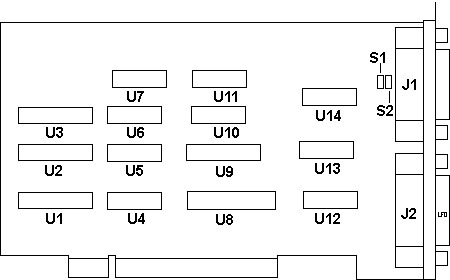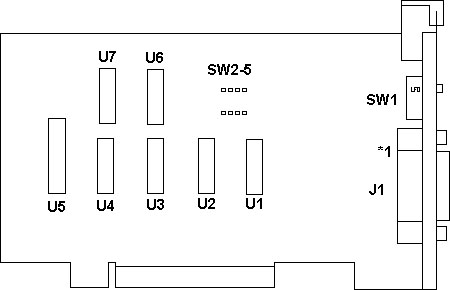|
@63B3.ADF "CH Products GameCard III-Automatic/MCA gameport adapter"
GameCard III-Plus/MCA gameport adapter - maybe a simple card, no ADF?
CH GameCard 3 Automatic Installation
CH GameCard 3 Automatic Diskette Most likely will work w/GC+
GameCard III Automatic MCA
GameCard III Plus - MCA
GameCard III Automatic MCA (GC3)

J1 Joystick A
J2 Joystick B
S1,2 switches
U1 74LS245N
U2,3 74LS244N
U4 74S86N
U5 74S08N
U6 74S00N
|
U7 74LS174N
U8 SN74ALS677ANT
U9 74ALS373N
U10 74LS138N
U11 74LS138N
U12 SN74LS123N
U13 74S32N
U14 NE558N
|
S1,2 setting for extra joystick switches
The only decision you need to make about the GameCard 3 is whether or not
you plan to use a three-axis joystick (a joystick with a throttle) such as the
CH Products FLIGHTSTICK, FLIGHTSTICK PRO, VIRTUAL PILOT or VIRTUAL PILOT PRO as
your A-joystick with a 2nd joystick as the B-joystick.
In this unlikely case, to prevent the third axis of your A-joystick from
interfering with your B-joystick, you can remove the two jumpers located behind
the connector for joystick A on the GameCard 3 Automatic.
If you remove the jumpers on the GameCard 3 Auto, you will not be able to
use the third axis (the throttle control) on the joysticks mentioned
above.
Programming Levels
The programming level of the GAMECARD 3 AUTOMATIC is displayed when CHJOY3
is run (every time you boot your computer). The programming levels fit into a
range of values between 0 and 31. Level 0 is the least sensitive setting for
the card and 31 is the most sensitive setting for the card. A very slow
computer (4.77 MHz) will set to the most sensitive setting (31). Where as, a
very fast computer (100+ MHz) will set to the least sensitive setting (0).
These programming levels are necessary because a fast computer samples the
gameport more often then a slow computer can. Therefore, an adjustment to the
gameport is required to get accurate results from the joystick. Most computers
will set to levels between 0 and 31, depending on the speed of the computer and
what is running in the system.
Many factors can effect the programming level setting, mostly TSR's and
memory managers, but anything that is running in the system can effect the
programming level. The more you have in your system and the more tasks your
system must perform, the slower the system gets.
The numbers that show up inside the JCENTER test program (TEST from JMENU)
represent the relative position of the joystick. The ideal joystick axis
numbers are usually between 80-120, with the joystick in its center position.
This is where most games can easily calibrate to and work with the joystick.
CHJOY3 attempts to estimate the rate/speed at which your computer will sample
the gameport and adjust the GAMECARD 3 AUTOMATIC so that the numbers, being
read form the joystick, fit into this 80-120 range.
150K Pot Joysticks
A special case is provided for use with 150K pot joysticks. If you want to
use automatic programming values, but adjust the value for 150K pot joysticks,
type CHJOY3 150. The programs on this disk normally expect the standard value
joystick (100K). To see the result of this special case, exit to DOS, type
CHJOY3 150, then run JCENTER. If stick center values within the 80-120 range
are obtained, you may wish to change the AUTOEXEC.BAT file to use this form
rather than a particular programming value.
GameCard III Plus - MCA

U1-4 74LS05N
U5 74LS244N
U6 SN74LS75N
U7 NE558N
|
SW1 Three position slider switch
SW2-5 outlines only
J1 Joystick DB15 port
|
SW1 Three position slider switch for sensitivity
SW2-5 outlines, maybe I/O addresses for ISA?
I see no ADF... Does it need an ADF? Some extremely simple cards don't...
FCCID HBZ3CY300-055
Joystick Technologies
GameCard III Plus - MCA
Choose one of three sensitivity levels, ranging from 70,000 to 200,000 ohms,
to match the needs of your application. Auto-CAD, for instance, requires a
lower sensitivity level than does Centipede. CH Products designed the GameCard
to avoid the timing problems that may be inescapable with cards meant for
machines with slower CPUs — it can be used in machines with clock speeds as
high as 20 MHz.
In addition, the GameCard supports four analog inputs, such as paddles, and
four digital inputs, such as push buttons. A Joystick with two buttons counts
as two digital and one analog input; hence the card's ability to support two
Joysticks.
|